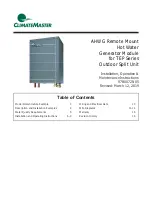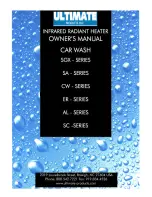
R e m o t e H W G
R e v i s e d : M a rc h 1 2 , 2 0 1 9
4
G e o t h e r m a l H e a t P u m p S y s t e m s
+RW2XWOHW
WRKRPH
,QVXODWHGZDWHUOLQHV
µ2'IWPD[LPXPRQHZD\PHWHUV
>PP2'PHWHUVPD[LPXP@
3RZHUHG
:DWHU
+HDWHU
8SSHU
HOHPHQWWR
120 - 130°
[49 - 54°C
/RZHU
HOHPHQWWR
100 - 110°F
[38 - 43°C
Cold Inlet from
Domestic supply
Shut-off
Valve #4
Shut-off
Valve #3
Shut Off
Valve #2
Shut-off
Valve #1
Insulated water lines - 5/8” OD, 50 ft maximum (one way)
[16mm OD, 15 meters maximum]
Upper element to 130°F [54°C]
(or owner preference)
Cold Inlet
Hot Outlet to
house
Powered
Water Heater
Cold Inlet from
Domestic supply
Hot Outlet
Unpowered
Water Heater
Field Supplied 3/4” brass nipple and “T”
Lower element to 120°F [49°C]
Shut-off
Valve #1
Shut-off
Valve #4
Shut-off
Valve #3
Shut Off
Valve #2
Figure 1: Typical HWG Installation (Outdoor Compressor
Section)
Figure 2: HWG Double Tank Installation (Outdoor Com-
pressor Section)
Hot Water Generator Module For
Outdoor Compressor Section
General Information
The HWG Module consists of an all-copper, vented double-
wall heat exchanger and a water-cooled bronze water
circulating pump. The pump is controlled by DXM2 control.
Power for the pump is provided from a remote 115 or 230
vac power source.
The HWG (Hot Water Generator) or desuperheater option
provides considerable operating cost savings by utilizing
excess heat energy from the heat pump to help satisfy
domestic hot water requirements. The HWG may be active
throughout the year, providing virtually free hot water when
the heat pump operates in the cooling mode or hot water at
the COP of the heat pump during operation in the heating
mode. Actual HWG water heating capacities are provided in
the appropriate heat pump performance data.
The temperature set point of the HWG is
fi
eld selectable on
the DXM2 to 125°F or 150°F . The 150°F set point allows
more heat storage from the HWG. For example, consider
the amount of heat that can be generated by the HWG when
using the 125°F set point, versus the amount of heat that can
be generated by the HWG when using the 150°F set point.
In a typical 50 gallon two-element electric water heater
the lower element should be turned down to 100°F, or the
lowest setting, to get the most from the HWG. The tank will
eventually stratify so that the lower 80% of the tank, or 40
gallons, becomes 100°F (controlled by the lower element).
The upper 20% of the tank, or 10 gallons, will be maintained
at 125°F (controlled by the upper element).
Using a 125°F set point, the HWG can heat the lower 40
gallons of water from 100°F to 125°F, providing up to 8,330
btu’s of heat. Using the 150°F set point, the HWG can heat
the same 40 gallons of water from 100°F to 150°F and the
remaining 10 gallons of water from 125°F to 150°F, providing
a total of up to 18,743 btu’s of heat, or more than twice as
much heat as when using the 125°F set point.
This example ignored standby losses of the tank. When
those losses are considered the savings are even greater.
Electric water heaters are recommended. If a gas, propane,
or oil water heater is used, a second preheat tank must be
installed (Figure 2). If the electric water heater has only a
single center element, the dual tank system is recommended
to insure a usable entering water temperature for the HWG.
Typically a single tank of at least 52 gallons (235 liters) is used
to limit installation costs and space. However, a dual tank, as
shown in Figure 2, is the most e
ffi
cient system, providing the
maximum storage and temperate source water to the HWG.
It is always advisable to use water softening equipment on
domestic water systems to reduce the scaling potential and
lengthen equipment life. In extreme water conditions, it may
be necessary to avoid the use of the HWG option since the
potential cost of frequent maintenance may o
ff
set or exceed
any savings. Consult water quality requirements table for
scaling potential.


































